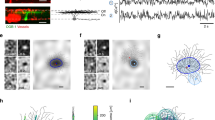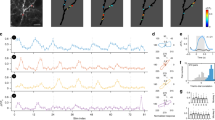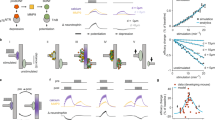Abstract
Active dendritic integration is thought to enrich the computational power of central neurons. However, a direct role of active dendritic processing in the execution of defined neuronal computations in intact neural networks has not been established. Here we used multi-site electrophysiological recording techniques to demonstrate that active dendritic integration underlies the computation of direction selectivity in rabbit retinal ganglion cells. Direction-selective retinal ganglion cells fire action potentials in response to visual image movement in a preferred direction. Dendritic recordings revealed that preferred-direction moving-light stimuli led to dendritic spike generation in terminal dendrites, which were further integrated and amplified as they spread through the dendritic arbor to the axon to drive action potential output. In contrast, when light bars moved in a null direction, synaptic inhibition vetoed neuronal output by directly inhibiting terminal dendritic spike initiation. Active dendritic integration therefore underlies a physiologically engaged circuit-based computation in the retina.
This is a preview of subscription content, access via your institution
Access options
Subscribe to this journal
Receive 12 print issues and online access
$209.00 per year
only $17.42 per issue
Buy this article
- Purchase on Springer Link
- Instant access to full article PDF
Prices may be subject to local taxes which are calculated during checkout







Similar content being viewed by others
References
Häusser, M., Spruston, N. & Stuart, G.J. Diversity and dynamics of dendritic signaling. Science 290, 739–744 (2000).
Johnston, D. & Narayanan, R. Active dendrites: colorful wings of the mysterious butterflies. Trends Neurosci. 31, 309–316 (2008).
Larkum, M.E., Zhu, J.J. & Sakmann, B. A new cellular mechanism for coupling inputs arriving at different cortical layers. Nature 398, 338–341 (1999).
Schiller, J., Major, G., Koester, H.J. & Schiller, Y. NMDA spikes in basal dendrites of cortical pyramidal neurons. Nature 404, 285–289 (2000).
Williams, S.R. & Stuart, G.J. Dependence of EPSP efficacy on synapse location in neocortical pyramidal neurons. Science 295, 1907–1910 (2002).
Ariav, G., Polsky, A. & Schiller, J. Submillisecond precision of the input-output transformation function mediated by fast sodium dendritic spikes in basal dendrites of CA1 pyramidal neurons. J. Neurosci. 23, 7750–7758 (2003).
Larkum, M.E., Nevian, T., Sandler, M., Polsky, A. & Schiller, J. Synaptic integration in tuft dendrites of layer 5 pyramidal neurons: a new unifying principle. Science 325, 756–760 (2009).
Branco, T., Clark, B.A. & Hausser, M. Dendritic discrimination of temporal input sequences in cortical neurons. Science 329, 1671–1675 (2010).
Remy, S., Csicsvari, J. & Beck, H. Activity-dependent control of neuronal output by local and global dendritic spike attenuation. Neuron 61, 906–916 (2009).
Harnett, M.T., Xu, N.-L., Magee, J.C. & Williams, S.R. Potassium channels control the interaction between active dendritic integration compartments in layer 5 cortical pyramidal neurons. Neuron 79, 516–529 (2013).
Losonczy, A. & Magee, J.C. Integrative properties of radial oblique dendrites in hippocampal CA1 pyramidal neurons. Neuron 50, 291–307 (2006).
Poirazi, P., Brannon, T. & Mel, B.W. Pyramidal neuron as two-layer neural network. Neuron 37, 989–999 (2003).
London, M. & Hausser, M. Dendritic computation. Annu. Rev. Neurosci. 28, 503–532 (2005).
Xu, N.-L. et al. Nonlinear dendritic integration of sensory and motor pathways produces an object localization signal. Nature 492, 247–251 (2012).
Ames, A. III & Nesbett, F.B. In vitro retina as an experimental model of the central nervous system. J. Neurochem. 37, 867–877 (1981).
Masland, R.H. The neuronal organization of the retina. Neuron 76, 266–280 (2012).
Wässle, H. Parallel processing in the mammalian retina. Nat. Rev. Neurosci. 5, 747–757 (2004).
Gollisch, T. & Meister, M. Eye smarter than scientists believed: neural computations in circuits of the retina. Neuron 65, 150–164 (2010).
Barlow, H.B. & Hill, R.M. Selective sensitivity to direction of movement in ganglion cells of the rabbit retina. Science 139, 412–414 (1963).
Barlow, H.B. & Levick, W.R. The mechanism of directionally selective units in rabbit's retina. J. Physiol. (Lond.) 178, 477–504 (1965).
Oyster, C.W. & Barlow, H.B. Direction-selective units in rabbit retina: distribution of preferred directions. Science 155, 841–842 (1967).
Taylor, W.R., He, S., Levick, W.R. & Vaney, D.I. Dendritic computation of direction selectivity by retinal ganglion cells. Science 289, 2347–2350 (2000).
Vaney, D.I., Sivyer, B. & Taylor, W.R. Direction selectivity in the retina: symmetry and asymmetry in structure and function. Nat. Rev. Neurosci. 13, 194–208 (2012).
Euler, T., Detwiler, P.B. & Denk, W. Directionally selective calcium signals in dendrites of starburst amacrine cells. Nature 418, 845–852 (2002).
Fried, S.I., Munch, T.A. & Werblin, F.S. Mechanisms and circuitry underlying directional selectivity in the retina. Nature 420, 411–414 (2002).
Lee, S., Kim, K. & Zhou, Z.J. Role of ACh-GABA cotransmission in detecting image motion and motion direction. Neuron 68, 1159–1172 (2010).
Briggman, K.L., Helmstaedter, M. & Denk, W. Wiring specificity in the direction-selectivity circuit of the retina. Nature 471, 183–188 (2011).
Wei, W., Hamby, A.M., Zhou, K. & Feller, M.B. Development of asymmetric inhibition underlying direction selectivity in the retina. Nature 469, 402–406 (2011).
Yonehara, K. et al. Spatially asymmetric reorganization of inhibition establishes a motion-sensitive circuit. Nature 469, 407–410 (2011).
Yoshida, K. et al. A key role of starburst amacrine cells in originating retinal directional selectivity and optokinetic eye movement. Neuron 30, 771–780 (2001).
Beier, K.T. et al. Transsynaptic tracing with vesicular stomatitis virus reveals novel retinal circuitry. J. Neurosci. 33, 35–51 (2013).
Koch, C., Poggio, T. & Torre, V. Nonlinear interactions in a dendritic tree: localization, timing and role in information processing. Proc. Natl. Acad. Sci. USA 80, 2799–2802 (1983).
Oesch, N., Euler, T. & Taylor, W.R. Direction-selective dendritic action potentials in rabbit retina. Neuron 47, 739–750 (2005).
Schachter, M.J., Oesch, N., Smith, R.G. & Taylor, W.R. Dendritic spikes amplify the synaptic signal to enhance detection of motion in a simulation of the direction-selective ganglion cell. PLoS Comput. Biol. 6, e1000899 (2010).
Velte, T.J. & Masland, R.H. Action potentials in the dendrites of retinal ganglion cells. J. Neurophysiol. 81, 1412–1417 (1999).
He, S., Jin, Z.F. & Masland, R.H. The nondiscriminating zone of directionally selective retinal ganglion cells: comparison with dendritic structure and implications for mechanism. J. Neurosci. 19, 8049–8056 (1999).
Rall, W. & Rinzel, J. Branch input resistance and steady attenuation for input to one branch of a dendritic neuron model. Biophys. J. 13, 648–687 (1973).
Chen, W.R., Midtgaard, J. & Shepherd, G.M. Forward and backward propagation of dendritic impulses and their synaptic control in mitral cells. Science 278, 463–467 (1997).
Stuart, G.J. & Sakmann, B. Active propagation of somatic action potentials into neocortical pyramidal cell dendrites. Nature 367, 69–72 (1994).
Brandon, C. Cholinergic neurons in the rabbit retina: dendritic branching and ultrastructural connectivity. Brain Res. 426, 119–130 (1987).
Famiglietti, E.V. Synaptic organization of complex ganglion cells in rabbit retina: type and arrangement of inputs to directionally selective and local-edge-detector cells. J. Comp. Neurol. 484, 357–391 (2005).
Murayama, M. et al. Dendritic encoding of sensory stimuli controlled by deep cortical interneurons. Nature 457, 1137–1141 (2009).
Lavzin, M., Rapoport, S., Polsky, A., Garion, L. & Schiller, J. Nonlinear dendritic processing determines angular tuning of barrel cortex neurons in vivo. Nature 490, 397–401 (2012).
Harnett, M.T., Makara, J.K., Spruston, N., Kath, W.L. & Magee, J.C. Synaptic amplification by dendritic spines enhances input cooperativity. Nature 491, 599–602 (2012).
Famiglietti, E.V. Synaptic organization of starburst amacrine cells in rabbit retina: analysis of serial thin sections by electron microscopy and graphic reconstruction. J. Comp. Neurol. 309, 40–70 (1991).
Yonehara, K. et al. The first stage of cardinal direction selectivity is localized to the dendrites of retinal ganglion cells. Neuron 79, 1078–1085 (2013).
Rhodes, P. The properties and implications of NMDA spikes in neocortical pyramidal cells. J. Neurosci. 26, 6704–6715 (2006).
Jadi, M., Polsky, A., Schiller, J. & Mel, B.W. Location-dependent effects of inhibition on local spiking in pyramidal neuron dendrites. PLoS Comput. Biol. 8, e1002550 (2012).
Gidon, A. & Segev, I. Principles governing the operation of synaptic inhibition in dendrites. Neuron 75, 330–341 (2012).
Williams, S.R. Spatial compartmentalization and functional impact of conductance in pyramidal neurons. Nat. Neurosci. 7, 961–967 (2004).
Acknowledgements
We are grateful to D. Vaney, W. Taylor, W. Levick, M. Harnett, R. Tweedale and G. Murphy for critically reading the manuscript. This work was supported by grants from the Australian Research Council (FT100100502 and DP130101630) and National Health and Medical Research Council (APP1004575) to S.R.W. and a University of Queensland Early Career Researcher Award (2012003384) to B.S.
Author information
Authors and Affiliations
Contributions
B.S. and S.R.W. conceived the project, designed the experiments and wrote the paper. B.S. conducted the experiments.
Corresponding author
Ethics declarations
Competing interests
The authors declare no competing financial interests.
Integrated supplementary information
Supplementary Figure 1 Asymmetrical distance-dependent attenuation of sub-threshold voltage responses in DSGCs.
(a) Distance-dependent increase in the local amplitude of dendritic voltage responses, but decrease in the amplitude of somatic voltage responses, when sub-threshold voltage responses were evoked by steps of negative current (–0.2 nA) delivered to the dendritic recording electrode (open symbols). The lines are exponential fits to the data. (b) Asymmetric distance-dependent attenuation of sub-threshold voltage responses, generated at dendritic (D-S) or somatic (S-D) sites (–0.2 nA). The lines are exponential fits to the data.
Supplementary Figure 2 Axo-somatic blockade of sodium channels does not disturb dendritic spike generation.
(a) Fluorescence micrograph of an ON-DSGC showing the placement of recording electrodes. Scale bar = 100 μm. (b) Local axo-somatic application of tetrodotoxin (TTX, 1 μM) attenuates somatically recorded action potentials (black traces) but not dendritic regenerative activity (red traces) evoked by a preferred-direction moving light bar. (c) In TTX, small-amplitude spikelets are recorded from the soma (black traces), but large-amplitude spikes are dendritically recorded (red trace). Section of the trace expanded from panel b. (d) Overlain spikes recorded from the soma (black) and dendrite (red) under control and following local axo-somatic TTX application. Under control, spikes were aligned at the peak of somatically recorded action potentials, and show dendritic spikes that precede the somatically recorded action potentials and back-propagating dendritically recorded action potentials evoked as the light bar sweeps across the receptive field. In TTX, spikes have been aligned at the peak of the somatically recorded spikelets, showing the generation of dendritic spikes as the light bar passes over the recorded dendritic subfield, but the absence of dendritically recorded activity as the light bar excites the contralateral dendritic subfield. In this example, the number of spiekelets generated by light-stimuli following axo-somatic TTX was 83 % of the number of action potentials generated under control, indicating that a large fraction of action potentials are driven by dendritic spikes. Using this criterion, analysis of pooled data indicated that 81 ± 12 % of somatically recorded action potentials were driven by dendritic spikes (n = 6, light responses).
Supplementary Figure 3 Dendro-somatic attenuation of small-amplitude terminal dendritic spikes.
The graph shows the amplitude distribution of isolated small-amplitude dendritic spikes recorded from parent dendritic and somatic sites. The line represents equality. The inset shows the cumulative probability distribution of the dendro-somatic voltage attenuation of small-amplitude dendritic spikes.
Supplementary Figure 4 Simulation of the dual-component rising phase of light-evoked large-amplitude dendritic spikes.
(a) Experimentally recorded light-evoked small-amplitude (terminal dendritic) spikes (upper offset traces), current-evoked parent dendritic spikes (middle traces) and the addition of these components (complex spikes). Dendritic recording was made 147 μm from the soma. (b) Time course of the positive phase of the first derivative measured at the base (5% of peak) of computed complex spikes as a function of the temporal delay between terminal and parent dendritic spikes. (c) Representative first derivative of the rising phase of complex spikes computed with 0.05 ms (red), 0.2 ms (blue) and 0.35 ms (black) temporal delay between components.
Supplementary Figure 5 Null-direction light-evoked inhibitory postsynaptic potentials are dendritically generated.
(a) Simultaneous dendritic (red trace, 245 μm from the soma) and somatic (black trace) recording of inhibitory postsynaptic potentials (IPSPs) evoked during the movement of null-direction light bars. (b) Overlain records show the large amplitude and fast kinetics of individual (thin traces) and averaged IPSPs (thick traces) at the dendritic recording site (red traces), and the attenuation and filtering of IPSPs as they spread to the soma (black traces). (c) The amplitude distribution of IPSPs at dendritic and somatic recording sites. The inset shows a cumulative probability distribution of the attenuation of dendritic IPSPs as they spread to the soma. Data have been pooled from n = 6 neurons, 427 events, dendritic recordings = 226 ± 20 μm from the soma.
Supplementary Figure 6 Dendritic spikes and action potentials are generated at high frequency in DSGCs.
(a) Somato-dendritic recording of repetitive high-frequency initiation of dendritic spikes evoked by an incremental series of positive current steps delivered to the dendritic recording electrode (245 μm from the soma). (b) Pooled current-discharge relationship generated in response to dendritic (red symbols) or somatic current (black symbols) (n = 10 cells, dendritic recordings 247 ± 12 μm from the soma). Lines represent the average frequency. (c) Cumulative probability distribution of preferred-direction light stimuli-evoked instantaneous action potential firing frequency (data pooled from n = 18 cells). (d) Axonal action potentials inactivate dendritic spike generation only at short inter-spike intervals. Representative example of the impact of axonal action potential firing evoked by short (2 ms) somatic current steps (black traces) on the initiation of dendritic spikes evoked by dendritic current steps (700 pA; 198 μm from the soma). Note that at 2 ms interval dendritic spike generation is blocked. (e) Impact of axonal action potentials evoked at decreasing time-delays on the normalized (to dendritic spike evoked in isolation) peak amplitude of dendritic activity evoked by the indicated amplitude current steps.
Supplementary Figure 7 Multi-layered active dendritic integration scheme for the computation of direction selectivity.
(a) Diagram of a proposed multi-compartmental active dendritic integration scheme, highlighting the presence of three integration areas; terminal dendrites (red), parent dendrites (blue), and axo-somatic (black). (b) Excitatory drive (bipolar cells) of terminal dendritic spike generation in DSGCs in response to light stimuli moving in the preferred-direction ignites the integration cascade. (c) Postsynaptic inhibition of terminal dendritic spike generation by starburst amacrine cells (SBACs) vetoes the integration cascade when light stimuli move in a null-direction.
Supplementary information
Supplementary Text and Figures
Supplementary Figures 1–7 (PDF 3326 kb)
Rights and permissions
About this article
Cite this article
Sivyer, B., Williams, S. Direction selectivity is computed by active dendritic integration in retinal ganglion cells. Nat Neurosci 16, 1848–1856 (2013). https://doi.org/10.1038/nn.3565
Received:
Accepted:
Published:
Issue Date:
DOI: https://doi.org/10.1038/nn.3565
This article is cited by
-
Rapid multi-directed cholinergic transmission in the central nervous system
Nature Communications (2021)
-
Type-specific dendritic integration in mouse retinal ganglion cells
Nature Communications (2020)
-
Dendro-dendritic cholinergic excitation controls dendritic spike initiation in retinal ganglion cells
Nature Communications (2017)
-
Dendritic integration: 60 years of progress
Nature Neuroscience (2015)
-
GABAergic neurotransmission and retinal ganglion cell function
Journal of Comparative Physiology A (2015)



